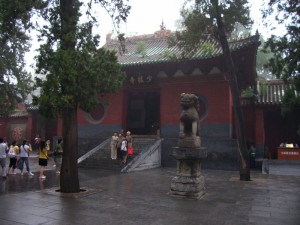Posts Tagged ‘Henan’
Tuesday, December 20th, 2011
China’s long and complex history has given rise to a range of different architectural styles. They not only fuse cultures’ structural and decorative forms, but are also influenced by Chinese concepts such as feng shui and yin and yang. The Shenzhen Daily presents the ten best examples of Chinese architecture in this series of articles:
I had the pleasure of visiting the Hongcun and Xidi ancient villages on my trip to Henan, Anhui and Zhejiang in 2009.
Tags: Ancient Towns, Ancient Villages, Anhui, Chengdu, Chinese architecture, Dayi, Dayi Liu Manor, Fujian tulou, Gongyi, Guangdong, Hakka, Henan, Hongcun, Huangshan, Imperial Prime Minister’s Palace, Jincheng, Kaiping, Kaiping diaolou, Kaiping forts, Kaiping watchtowers, Kang Baiwan Manor, Lingshi, Longyan, Mizhi, Qiao Family Compound, Qixian, Shaanxi, Shanxi, Shenzhen Daily, Sichuan, Tulou, Wang Family Compound, Xidi, Yulin, Yulin Manor of Jiang Yaozu, Zhangzhou Posted in China Travel, Chinese History, My China Trips | Comments Off on Ten best examples of Chinese architecture
Sunday, May 15th, 2011
From the end of December 2010 we returned for my fifth trip to China, spending three amazing weeks visiting China’s capital Beijing as well as Tianjin, located south of Beijing, and Zhengzhou in central China. You can now read the story of my trip and see the pictures.
Saturday, March 19th, 2011
The 28th Luoyang Peony Festival is set to be held in Luoyang City in central China’s Henan Province from 1 April to 5 May 2010. The peony is a traditional flora symbol of China, with very beautiful color and fragrance, and during the festival Luoyang will be turned into a sea of flowers. Read more in the Confucius Institute Online article Luoyang Peony Festival Opens Next Month.
While in Luoyang make sure to visit the extraordinary World Heritage listed Longmen Grottoes, and the White Horse Temple which is described as the cradle of Buddhism in China. I had the pleasure of visiting both on my trip to Henan Province in 2008. These are among the many cultural and natural attractions of China’s Henan Province – to find out more visit the Henan Province Tourism Administration’s “Amazing Henan” website.
Monday, January 31st, 2011
Last night we went to the cinema to see the new movie “Shaolin”. Much more than just a Kung Fu film, the fast-paced, breathtaking Shaolin is an experience in the benevolence, wisdom and enlightenment of Chinese Buddhism. I visited the Shaolin Temple, which is located at Dengfeng near Zhengzhou in Henan Province, during my  trip to Henan, Anhui, and Zhejiang in 2009. Rather than risk damage to the real Shaolin Temple, which last year gained World Heritage listing, a replica film set was built in Zhejiang Province. trip to Henan, Anhui, and Zhejiang in 2009. Rather than risk damage to the real Shaolin Temple, which last year gained World Heritage listing, a replica film set was built in Zhejiang Province.
Shaolin begins with feuding warlords trying to expand their power by warring over neighboring lands. Fuelled by his success on the battlefield, young and arrogant warlord Hao Jie sneers at Shaolin’s masters when he beats one of them in a duel. But pride comes before a fall. When his own family is wiped out by a rival warlord, Hao is forced to take refuge with the monks. There he confronts the harm he has done, learning Shaolin martial arts and repenting. As the civil unrest spreads and the people suffer, Hao and the Shaolin masters are forced to take a stand against the evil warlords and foreign colonists who are exploiting the Chinese people to plunder ancient treasures (something that has sadly happened in real life, one of the worst examples being the French and English looting and destruction of Yuanmingyuan).
Find out more at Emperor Motion Pictures – Shaolin.
Tags: Buddhism, Buddhist, Dengfeng, Henan, Kung Fu, Mount Song, Shaolin, Shaolin Temple, Songshan, Zhejiang, Zhengzhou Posted in China News, Chinese History | Comments Off on Movie – Shaolin
Monday, August 2nd, 2010
 UNESCO’s World Heritage Committee has decided at its 34th meeting in Brazil to add the historic monuments of Dengfeng and the Danxia landform to the World Heritage list. To find out more visit the CCTV9 Special Feature. UNESCO’s World Heritage Committee has decided at its 34th meeting in Brazil to add the historic monuments of Dengfeng and the Danxia landform to the World Heritage list. To find out more visit the CCTV9 Special Feature.
The historic monuments of Dengfeng are situated in and around Songshan (Mount Song) in Henan Province in central China. Songshan, known in Chinese as Zhongyue, is one of the five sacred mountains in China. The monuments consist of 13 ancient structures and sites including the Shaolin Temple and Pagoda Forest that we visited during our 2009 trip to Henan, Anhui and Zhejiang Provinces – read the story and see the pictures.
The Danxia landform consists of red sedimentary rock located across six Chinese provinces. It is characterised by spectacular cliffs and a range of erosional landforms, including dramatic natural pillars, towers, ravines, valleys and waterfalls. These rugged landscapes have helped to conserve sub-tropical broad-leaved evergreen forests, and host many species of flora and fauna, about 400 of which are considered rare or threatened. For some pictures see this slideshow on the Sina website (click on the photos to advance the slideshow).
For a full list of World Heritage properties in China visit the UNESCO World Heritage website. West Lake in Hangzhou city, which we also visited on our 2009 trip, is planned for nomination for World Heritage listing next year.
Tags: Danxia, Dengfeng, Hangzhou, Henan, Mount Song, Pagoda Forest, Shaolin Temple, Songshan, UNESCO, West Lake, World Heritage Posted in China News, Chinese History | Comments Off on Dengfeng historic monuments and Danxia landform added to World Heritage list
|
|

